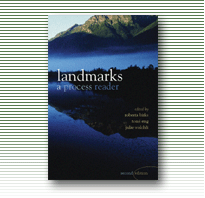 |
|
|
|
|
| Welcome | |
|
|
|
| Table of Contents | |
| Preface to the Instructor | |
| Preface to the Student | |
| Weblinks - Topics and Issues | |
| Weblinks - Online Writing Resources | |
| Instructor's Resources | |
|
|
|
 |
|
|
Copyright © 2004 |
|
 |
|
Preface to the Student |
|
landmark...n l : an object that marks a course or boundary or serves as a guide 2 : an event that marks a turning point 3 : a
structure of unusual historical and, usually, aesthetic interest Introduction Landmarks offers challenging essays written largely, but not exclusively, by Canadian writers. The text is student-centred in its approach. By taking students through the processes of invention, development, arrangement, style, and delivery, we adapt the model of classical rhetoric, making it relevant for writers today. We also provide chapters that focus on writing analyses and research papers; here, students have the opportunity to apply the strategies they have learned to specific academic writing situations across the disciplines.The second edition of Landmarks builds on the goals of the first edition by incorporating feedback from students and instructors who have used the textbook. This new edition provides ten new essays whose authors range from past Canadian politicians to current journalists and academics. It also expands significantly on how to analyze texts by providing students with a step-by-step process for writing a rhetorical analysis. The chapter on writing research papers presents added details about evaluating and documenting electronic sources, as well as examples of documentation styles from a range of academic fields. We hope that Landmarks will serve as a useful guide for all those engaged in exploring the process of writing. Organization The essays in Landmarks are organized around the steps in the writing process.
Each essay is prefaced by a biographical note about the author and followed by Explorations, which provides questions that help students to explore their initial, personal reactions to the ideas in each essay. The organization of the text will help students understand the decisions they must make in inventing, developing, and arranging ideas, considering style, and projecting their voices into the public forum. The final two chapters suggest ways in which students can apply these steps to two specific types of writing: rhetorical analyses and research papers. Features
Supplements Landmarks is supplemented by a website (www.pearsoned.ca/text/birks) that offers annotated links to related topics and online writing resources, and provides course outlines developed by instructors who are currently using this textbook. Acknowledgments We are indebted to many people who helped at various stages of this project. Students, instructors, and reviewers offered valuable feedback on the first edition of Landmarks, which helped us make key editorial decisions for this edition. Our thanks to Carole Birks who provided research assistance and Kevin Stewart who offered insightful feedback on the manuscript. At Pearson Education Canada Marianne Minaker, Acquisitions Editor, Marta Tomins, Executive Developmental Editor, Paula Druzga, Developmental Editor, Avivah Wargon, Supervising Editor, and Susan Adlam, freelance copy editor, have all been efficient and enthusiastic guides. Special thanks to our families and friends whose support and encouragement have been indispensable.
The definition of landmark on the back cover and on this page appears by permission. From The Merriam-Webster Dictionary © 1997 by Merriam-Webster, Incorporated (www.Merriam-Webster.com). |
|